Compromised Improvement of Poor Visibility Due to PM Chemical Composition Changes in South Korea
Abstract
1. Introduction
2. Materials and Methods
2.1. Observations
2.2. Visibility Data Reconstruction
3. Results and Discussion
3.1. Annual Visibility Trend
3.2. Poor Visibility Analysis
3.2.1. Annual Poor Visibility
3.2.2. Poor Visibility in Rush Hour
3.3. Factors Affecting Poor Visibility
3.4. Variations of SO42− and NO3− Concentrations
3.4.1. Budget Changes of Light-Extinction Coefficient
3.4.2. Effects of Changes in SOx and NOx Emissions on Visibility
4. Conclusions
Author Contributions
Funding
Data Availability Statement
Acknowledgments
Conflicts of Interest
References
- Breysse, P.N.; Diette, G.B.; Matsui, E.C.; Butz, A.M.; Hansel, N.N.; McCormack, M.C. Indoor air pollution and asthma in children. Proc. Am. Thorac. Soc. 2010, 7, 102–106. [Google Scholar] [CrossRef] [PubMed]
- Raaschou-Nielsen, O.; Andersen, Z.J.; Beelen, R.; Samoli, E.; Stafoggia, M.; Weinmayr, G.; Hoffmann, B.; Fischer, P.; Nieuwenhuijsen, M.J.; Brunekreef, B.; et al. Air pollution and lung cancer incidence in 17 European cohorts: Prospective analyses from the European Study of Cohorts for Air Pollution Effects (ESCAPE). Lancet Oncol. 2013, 14, 813–822. [Google Scholar] [CrossRef]
- Ahmed, E.; Kim, K.H.; Shon, Z.H.; Song, S.K. Long-term trend of airborne particulate matter in Seoul, Korea from 2004 to 2013. Atmos. Environ. 2015, 101, 125–133. [Google Scholar] [CrossRef]
- Kim, Y.P.; Lee, G. Trend of air quality in Seoul: Policy and science. Aerosol Air Qual. Res. 2018, 18, 2141–2156. [Google Scholar] [CrossRef]
- Jo, E.J.; Lee, W.S.; Jo, H.Y.; Kim, C.H.; Eom, J.S.; Mok, J.H.; Kim, M.H.; Lee, K.; Kim, K.U.; Lee, M.K.; et al. Effects of particulate matter on respiratory disease and the impact of meteorological factors in Busan, Korea. Respir. Med. 2017, 124, 79–87. [Google Scholar] [CrossRef] [PubMed]
- Kim, H.-K.; Song, C.-K.; Han, K.M.; Eo, Y.D.; Song, C.H.; Park, R.; Hong, S.-C.; Kim, S.-K.; Woo, J.-H. Impact of biogenic emissions on early summer ozone and fine particulate matter exposure in the Seoul Metropolitan Area of Korea. Air Qual. Atmos. Health 2018, 11, 1021–1035. [Google Scholar] [CrossRef]
- Gao, J.; Woodward, A.; Vardoulakis, S.; Kovats, S.; Wilkinson, P.; Li, L.; Xu, L.; Li, J.; Yang, J.; Li, J.; et al. Haze, public health and mitigation measures in China: A review of the current evidence for further policy response. Sci. Total Environ. 2017, 578, 148–157. [Google Scholar] [CrossRef]
- Hyslop, N.P. Impaired visibility: The air pollution people see. Atmos. Environ. 2009, 43, 182–195. [Google Scholar] [CrossRef]
- Chang, D.; Song, Y.; Liu, B. Visibility trends in six megacities in China 1973–2007. Atmos. Res. 2009, 94, 161–167. [Google Scholar] [CrossRef]
- See, S.W.; Balasubramanian, R.; Wang, W. A study of the physical, chemical, and optical properties of ambient aerosol particles in Southeast Asia during hazy and nonhazy days. J. Geophys. Res. Atmos. 2006, 111, D10S08. [Google Scholar] [CrossRef]
- Kim, Y.J.; Kim, K.W.; Kim, S.D.; Lee, B.K.; Han, J.S. Fine particulate matter characteristics and its impact on visibility impairment at two urban sites in Korea: Seoul and Incheon. Atmos. Environ. 2006, 40, 593–605. [Google Scholar] [CrossRef]
- Cao, J.J.; Wang, Q.Y.; Chow, J.C.; Watson, J.G.; Tie, X.X.; Shen, Z.X.; Wang, P.; An, Z.S. Impacts of aerosol compositions on visibility impairment in Xi’an, China. Atmos. Environ. 2012, 59, 559–566. [Google Scholar] [CrossRef]
- Xiao, S.; Wang, Q.Y.; Cao, J.J.; Huang, R.J.; Chen, W.D.; Han, Y.M.; Xu, H.M.; Liu, S.X.; Zhou, Y.Q.; Wang, P.; et al. Long-term trends in visibility and impacts of aerosol composition on visibility impairment in Baoji, China. Atmos. Res. 2014, 149, 88–95. [Google Scholar] [CrossRef]
- Deng, H.; Tan, H.; Li, F.; Cai, M.; Chan, P.W.; Xu, H.; Huang, X.; Wu, D. Impact of relative humidity on visibility degradation during a haze event: A case study. Sci. Total Environ. 2016, 569–570, 1149–1158. [Google Scholar] [CrossRef]
- Horvath, H. Atmospheric light absorption-A review. Atmos. Environ. Part A Gen. Top. 1993, 27, 293–317. [Google Scholar] [CrossRef]
- Zhang, Q.; Quan, J.; Tie, X.; Li, X.; Liu, Q.; Gao, Y.; Zhao, D. Effects of meteorology and secondary particle formation on visibility during heavy haze events in Beijing, China. Sci. Total Environ. 2015, 502, 578–584. [Google Scholar] [CrossRef]
- Chow, J.C.; Watson, J.G.; Fujita, E.M.; Lu, Z.; Lawson, D.R.; Ashbaugh, L.L. Temporal and spatial variations of PM2.5 and PM10 aerosol in the Southern California air quality study. Atmos. Environ. 1994, 28, 2061–2080. [Google Scholar] [CrossRef]
- Kim, Y.; Yi, S.M.; Heo, J. Fifteen-year trends in carbon species and PM2.5 in Seoul, South Korea (2003–2017). Chemosphere 2020, 261, 127750. [Google Scholar] [CrossRef]
- Bae, M.; Kim, B.U.; Kim, H.C.; Kim, J.; Kim, S. Role of emissions and meteorology in the recent PM2.5 changes in China and South Korea from 2015 to 2018. Environ. Pollut. 2021, 270, 116233. [Google Scholar] [CrossRef]
- Cho, J.H.; Kim, H.S.; Chung, Y.S. Spatio-temporal changes of PM10 trends in South Korea caused by East Asian atmospheric variability. Air Qual. Atmos. Health 2021, 14, 1001–1016. [Google Scholar] [CrossRef]
- Joo, S.; Dehkhoda, N.; Shin, J.; Park, M.E.; Sim, J.; Noh, Y. A Study on the Long-Term Variations in Mass Extinction Efficiency Using Visibility Data in South Korea. Remote Sens. 2022, 14, 1592. [Google Scholar] [CrossRef]
- Lee, J.Y.; Jo, W.K.; Chun, H.H. Long-term trends in visibility and its relationship with mortality, air-quality index, and meteorological factors in selected areas of Korea. Aerosol Air Qual. Res. 2015, 15, 673–681. [Google Scholar] [CrossRef]
- Kim, K.W. Optical Properties of Size-Resolved Aerosol Chemistry and Visibility Variation Observed in the Urban Site of Seoul, Korea. Aerosol Air Qual. Res. 2015, 15, 271–283. [Google Scholar] [CrossRef]
- Kim, M.; Lee, K.; Lee, Y.H. Visibility Data Assimilation and Prediction Using an Observation Network in South Korea. Pure Appl. Geophys. 2020, 177, 1125–1141. [Google Scholar] [CrossRef]
- Kim, K.W. The comparison of visibility measurement between image-based visual range, human eye-based visual range, and meteorological optical range. Atmos. Environ. 2018, 190, 74–86. [Google Scholar] [CrossRef]
- Yu, Z.; Wang, J.; Liu, X.; He, L.; Cai, X.; Ruan, S. A new video-camera-based visiometer system. Atmos. Sci. Lett. 2019, 20, e925. [Google Scholar] [CrossRef]
- Tang, F.; Ma, S.; Yang, L.; Du, C.; Tang, Y. A new visibility measurement system based on a black target and a comparative trial with visibility instruments. Atmos. Environ. 2016, 143, 229–236. [Google Scholar] [CrossRef]
- Choi, J.; Park, R.J.; Lee, H.M.; Lee, S.; Jo, D.S.; Jeong, J.I.; Henze, D.K.; Woo, J.H.; Ban, S.J.; Lee, M.D.; et al. Impacts of local vs. trans-boundary emissions from different sectors on PM2.5 exposure in South Korea during the KORUS-AQ campaign. Atmos. Environ. 2019, 203, 196–205. [Google Scholar] [CrossRef]
- Bae, C.; Kim, B.-U.; Kim, H.C.; Yoo, C.; Kim, S. Long-Range Transport Influence on Key Chemical Components of PM2.5 in the Seoul Metropolitan Area, South Korea, during the Years 2012–2016. Atmosphere 2020, 11, 48. [Google Scholar] [CrossRef]
- Park, S.S.; Jung, S.A.; Gong, B.J.; Cho, S.Y.; Lee, S.J. Characteristics of PM2.5 haze episodes revealed by highly time-resolved measurements at an air pollution monitoring supersite in Korea. Aerosol Air Qual. Res. 2013, 13, 957–976. [Google Scholar] [CrossRef]
- Gao, L.; Jia, G.; Zhang, R.; Che, H.; Fu, C.; Wang, T.; Zhang, M.; Jiang, H.; Yan, P. Visual range trends in the Yangtze River Delta Region of China, 1981–2005. J. Air Waste Manag. Assoc. 2011, 61, 843–849. [Google Scholar] [CrossRef] [PubMed]
- Chen, X.; Li, X.; Yuan, X.; Zeng, G.; Liang, J.; Li, X.; Xu, W.; Luo, Y.; Chen, G. Effects of human activities and climate change on the reduction of visibility in Beijing over the past 36 years. Environ. Int. 2018, 116, 92–100. [Google Scholar] [CrossRef] [PubMed]
- Tai, H.; Zhuang, Z.; Sun, D. Development and accuracy of a multipoint method for measuring visibility. Appl. Opt. 2017, 56, 7952–7959. [Google Scholar] [CrossRef] [PubMed]
- Mahowald, N.M.; Ballantine, J.A.; Feddema, J.; Ramankutty, N. Global trends in visibility: Implications for dust sources. Atmos. Chem. Phys. 2007, 7, 3309–3339. [Google Scholar] [CrossRef]
- Baddock, M.C.; Strong, C.L.; Leys, J.F.; Heidenreich, S.K.; Tews, E.K.; McTainsh, G.H. A visibility and total suspended dust relationship. Atmos. Environ. 2014, 89, 329–336. [Google Scholar] [CrossRef]
- Ozer, P.; Laghdaf, M.B.O.M.; Lemine, S.O.M.; Gassani, J. Estimation of air quality degradation due to Saharan dust at Nouakchott, Mauritania, from horizontal visibility data. Water Air Soil Pollut. 2007, 178, 79–87. [Google Scholar] [CrossRef]
- Malm, W.C.; Day, D.E. Estimates of aerosol species scattering characteristics as a function of relative humidity. Atmos. Environ. 2001, 35, 2845–2860. [Google Scholar] [CrossRef]
- Malm, W.C.; Sisler, J.F.; Huffman, D.; Eldred, R.A.; Cahill, T.A. Spatial and seasonal trends in particle concentration and optical extinction in the United States. J. Geophys. Res. 1994, 99, 1347–1370. [Google Scholar] [CrossRef]
- Pitchford, M.; Malm, W.; Schichtel, B.; Kumar, N.; Lowenthal, D.; Hand, J. Revised algorithm for estimating light extinction from IMPROVE particle speciation data. J. Air Waste Manag. Assoc. 2007, 57, 1326–1336. [Google Scholar] [CrossRef]
- NIER. Study on the Management Plan of Metropolitan Air Quality; National Institute of Environmental Research: Incheon, Korea, 2006. (In Korean) [Google Scholar]
- Li, Y.; Huang, H.X.H.; Griffith, S.M.; Wu, C.; Lau, A.K.H.; Yu, J.Z. Quantifying the relationship between visibility degradation and PM2.5 constituents at a suburban site in Hong Kong: Differentiating contributions from hydrophilic and hydrophobic organic compounds. Sci. Total. Environ. 2017, 575, 1571–1581. [Google Scholar] [CrossRef]
- Qu, W.J.; Wang, J.; Zhang, X.Y.; Wang, D.; Sheng, L.F. Influence of relative humidity on aerosol composition: Impacts on light extinction and visibility impairment at two sites in coastal area of China. Atmos. Res. 2015, 153, 500–511. [Google Scholar] [CrossRef]
- Park, S.M.; Song, I.H.; Park, J.S.; Oh, J.; Moon, K.J.; Shin, H.J.; Ahn, J.Y.; Lee, M.D.; Kim, J.; Lee, G. Variation of PM2.5 chemical compositions and their contributions to light extinction in Seoul. Aerosol Air Qual. Res. 2018, 18, 2220–2229. [Google Scholar] [CrossRef]
- Koschmieder, H. Theorie der horizontalen Sichtweite. Beitr. Phys. Freien Atm. 1924, 12, 33–55. [Google Scholar]
- Wang, Y.; Gao, W.; Wang, S.; Song, T.; Gong, Z.; Ji, D.; Wang, L.; Liu, Z.; Tang, G.; Huo, Y.; et al. Contrasting trends of PM2.5 and surface-ozone concentrations in China from 2013 to 2017. Natl. Sci. Rev. 2020, 7, 1331–1339. [Google Scholar] [CrossRef]
- Zhao, S.; Yin, D.; Yu, Y.; Kang, S.; Qin, D.; Dong, L. PM2.5 and O3 pollution during 2015–2019 over 367 Chinese cities: Spatiotemporal variations, meteorological and topographical impacts. Environ. Pollut. 2020, 264, 114694. [Google Scholar] [CrossRef] [PubMed]
- Xiao, Q.; Zheng, Y.; Geng, G.; Chen, C.; Huang, X.; Che, H.; Zhang, X.; He, K.; Zhang, Q. Separating emission and meteorological contributions to long-term PM2.5 trends over eastern China during 2000–2018. Atmos. Chem. Phys. 2021, 21, 9475–9496. [Google Scholar] [CrossRef]
- Kumar, N.; Park, R.J.; Jeong, J.I.; Woo, J.H.; Kim, Y.; Johnson, J.; Yarwood, G.; Kang, S.; Chun, S.; Knipping, E. Contributions of international sources to PM2.5 in South Korea. Atmos. Environ. 2021, 261, 118542. [Google Scholar] [CrossRef]
- Zou, J.; Liu, Z.; Hu, B.; Huang, X.; Wen, T.; Ji, D.; Liu, J.; Yang, Y.; Yao, Q.; Wang, Y. Aerosol chemical compositions in the North China Plain and the impact on the visibility in Beijing and Tianjin. Atmos. Res. 2018, 201, 235–246. [Google Scholar] [CrossRef]
- Dumka, U.C.; Tiwari, S.; Kaskaoutis, D.G.; Hopke, P.K.; Singh, J.; Srivastava, A.K.; Bisht, D.S.; Attri, S.D.; Tyagi, S.; Misra, A.; et al. Assessment of PM 2.5 chemical compositions in Delhi: Primary vs secondary emissions and contribution to light extinction coefficient and visibility degradation. J. Atmos. Chem. 2016, 74, 423–450. [Google Scholar] [CrossRef]
- Fu, C.; Wu, J.; Gao, Y.; Zhao, D.; Han, Z. Consecutive extreme visibility events in China during 1960–2009. Atmos. Environ. 2013, 68, 1–7. [Google Scholar] [CrossRef]
- Sun, X.; Zhao, T.; Liu, D.; Gong, S.; Xu, J.; Ma, X. Quantifying the influences of PM2.5 and relative humidity on change of atmospheric visibility over recent winters in an urban area of East China. Atmosphere 2020, 11, 461. [Google Scholar] [CrossRef]
- Luo, C.H.; Wen, C.Y.; Yuan, C.S.; Liaw, J.J.; Lo, C.C.; Chiu, S.H. Investigation of urban atmospheric visibility by high-frequency extraction: Model development and field test. Atmos. Environ. 2005, 39, 2545–2552. [Google Scholar] [CrossRef]
- Oak, Y.J.; Park, R.J.; Schroeder, J.R.; Crawford, J.H.; Blake, D.R.; Weinheimer, A.J.; Woo, J.H.; Kim, S.W.; Yeo, H.; Fried, A.; et al. Evaluation of simulated O3 production efficiency during the KORUS-AQ campaign: Implications for anthropogenic NOx emissions in Korea. Elementa 2019, 7, 56. [Google Scholar] [CrossRef]
- Ryu, Y.H.; Baik, J.J.; Kwak, K.H.; Kim, S.; Moon, N. Impacts of urban land-surface forcing on ozone air quality in the Seoul metropolitan area. Atmos. Chem. Phys. 2013, 13, 2177–2194. [Google Scholar] [CrossRef]
- Fountoukis, C.; Nenes, A. ISORROPIAII: A computationally efficient thermodynamic equilibrium model for K+-Ca2+-Mg2+-NH4 +-Na+-SO4 2−-NO3−-Cl−-H2O aerosols. Atmos. Chem. Phys. 2007, 7, 4639–4659. [Google Scholar] [CrossRef]
- Seinfeld, J.H.; Pandis, S.N. Atmospheric Chemistry and Physics: From Air Pollution to Climate Change; John Wiley & Sons: Hoboken, NJ, USA, 2016. [Google Scholar]
- Lim, Y.B.; Seo, J.; Kim, J.Y.; Kim, Y.P.; Jin, H.C. Local formation of sulfates contributes to the urban haze with regional transport origin. Environ. Res. Lett. 2020, 15, 084034. [Google Scholar] [CrossRef]
- Seo, J.; Lim, Y.B.; Youn, D.; Kim, J.Y.; Jin, H.C. Synergistic enhancement of urban haze by nitrate uptake into transported hygroscopic particles in the Asian continental outflow. Atmos. Chem. Phys. 2020, 20, 7575–7594. [Google Scholar] [CrossRef]
- Kim, E.; Kim, B.U.; Kim, H.C.; Kim, S. Direct and cross impacts of upwind emission control on downwind PM2.5 under various NH3 conditions in Northeast Asia. Environ. Pollut. 2021, 268, 115794. [Google Scholar] [CrossRef]
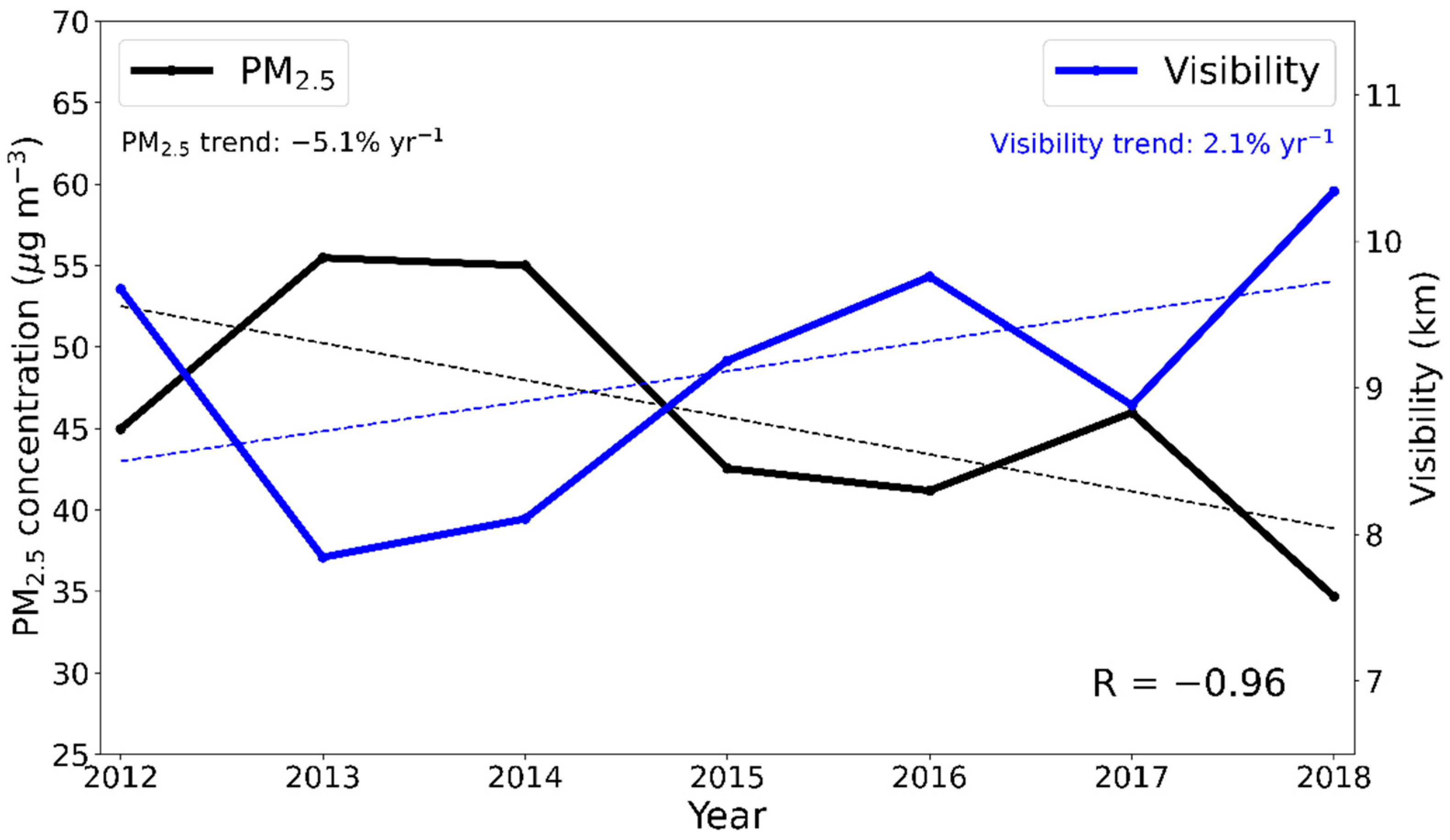
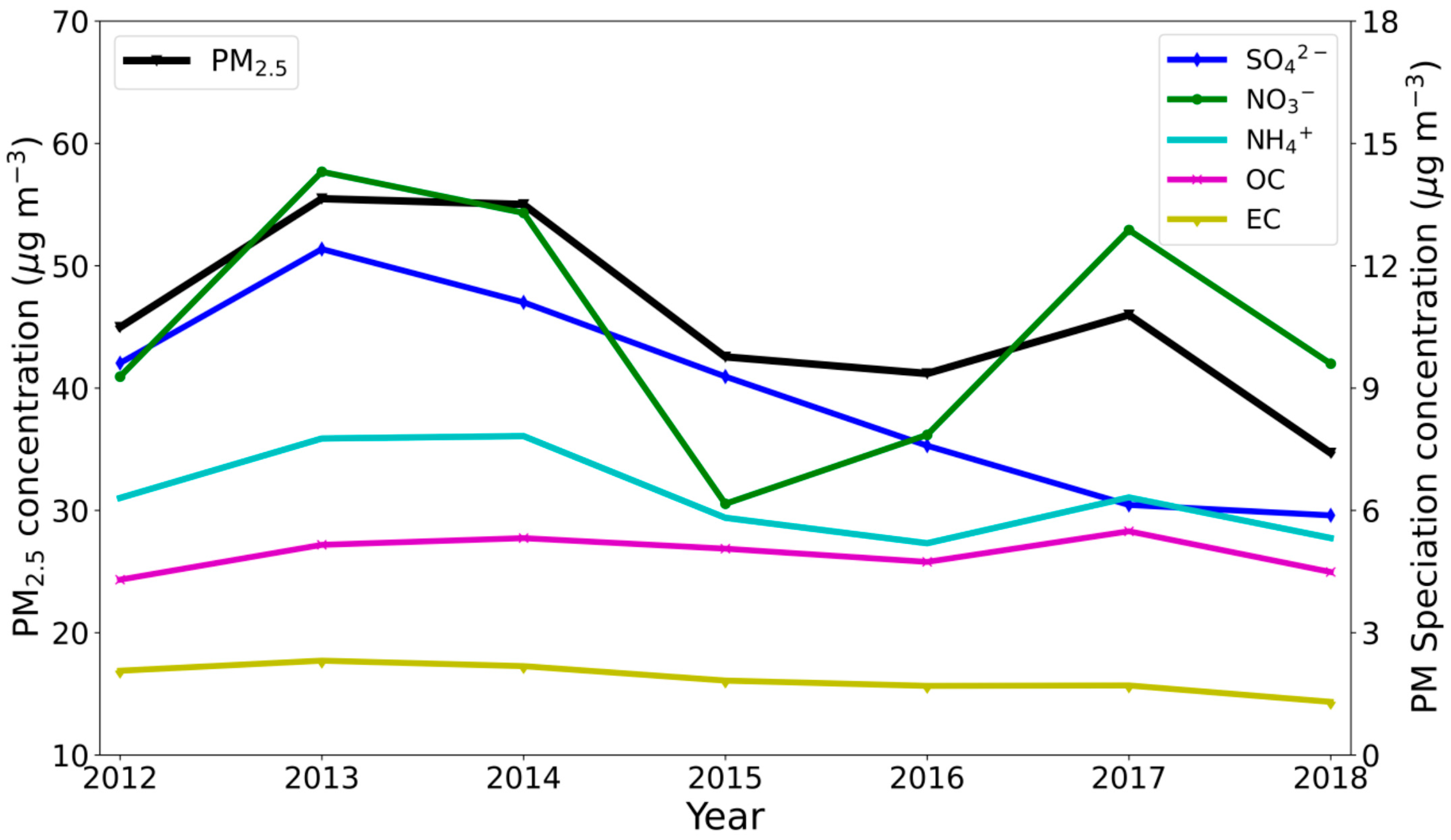
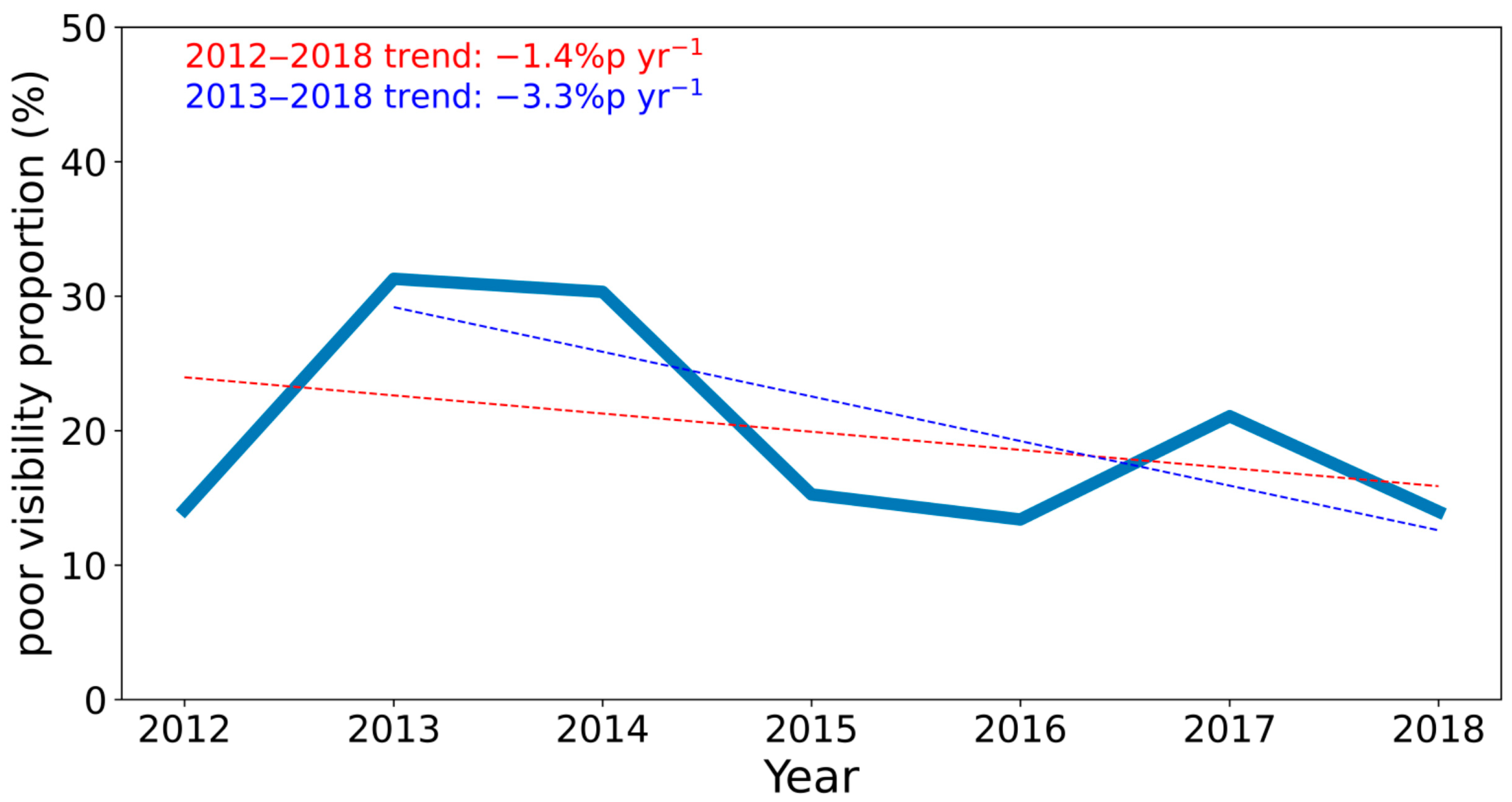
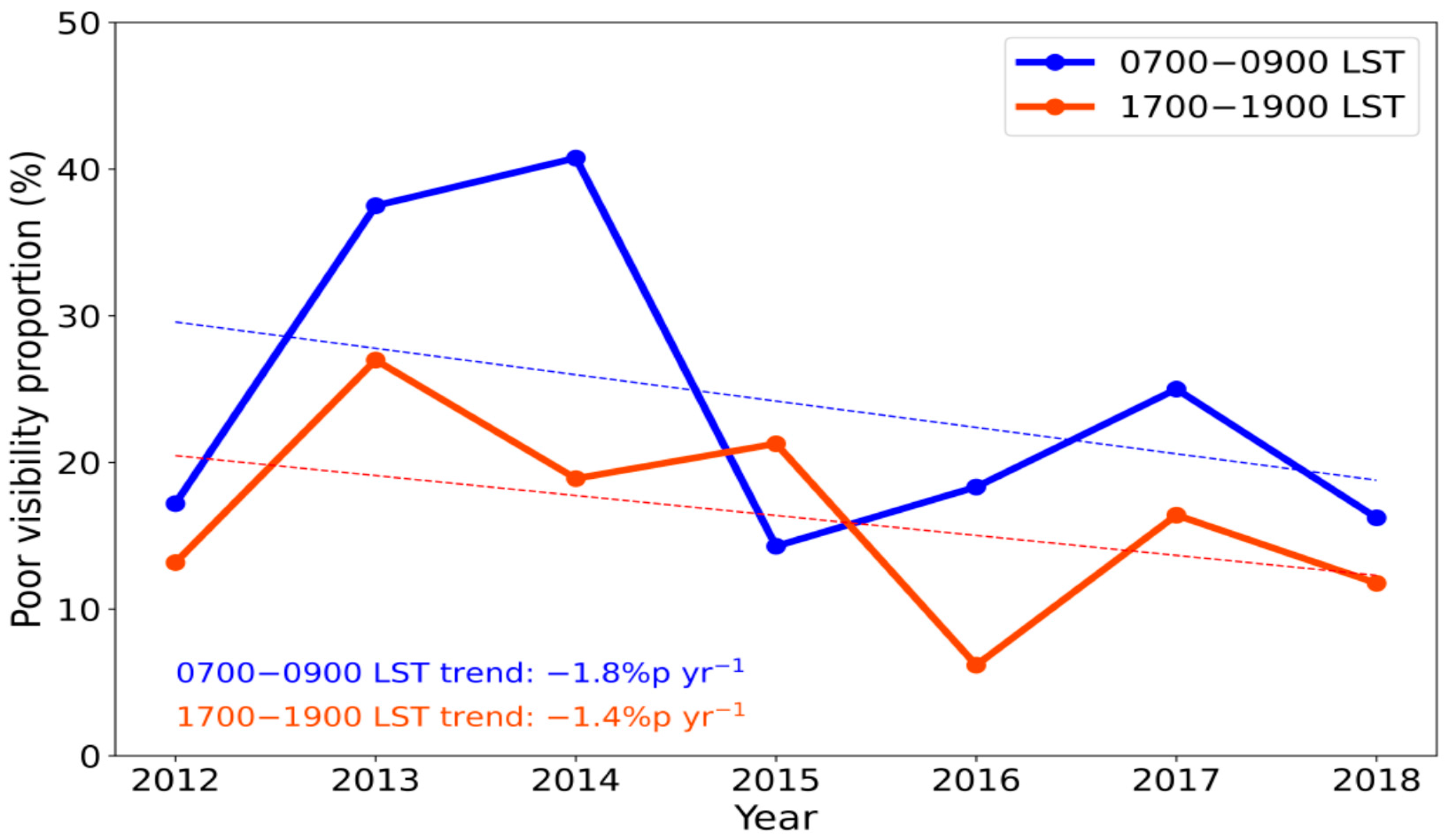
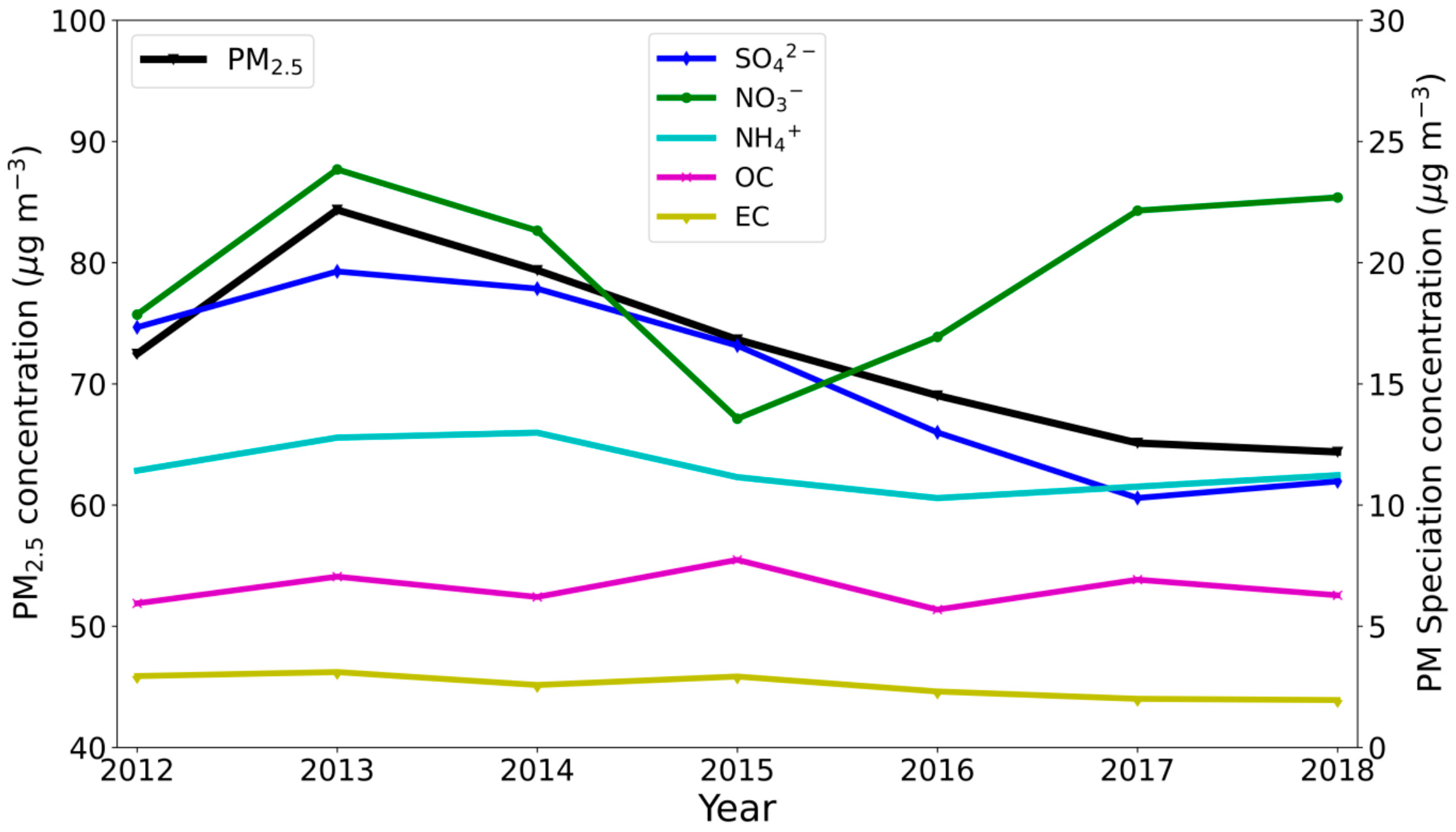
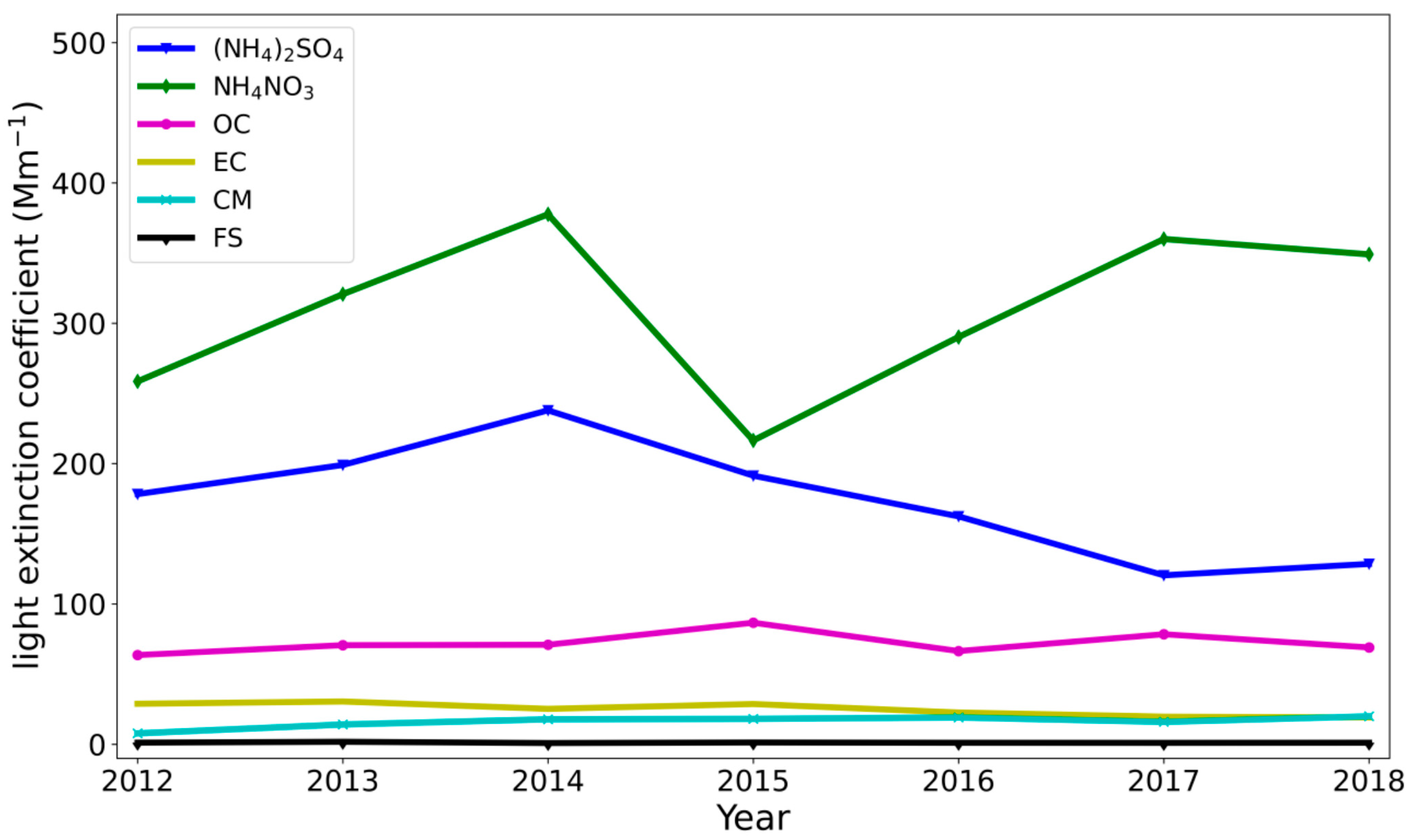
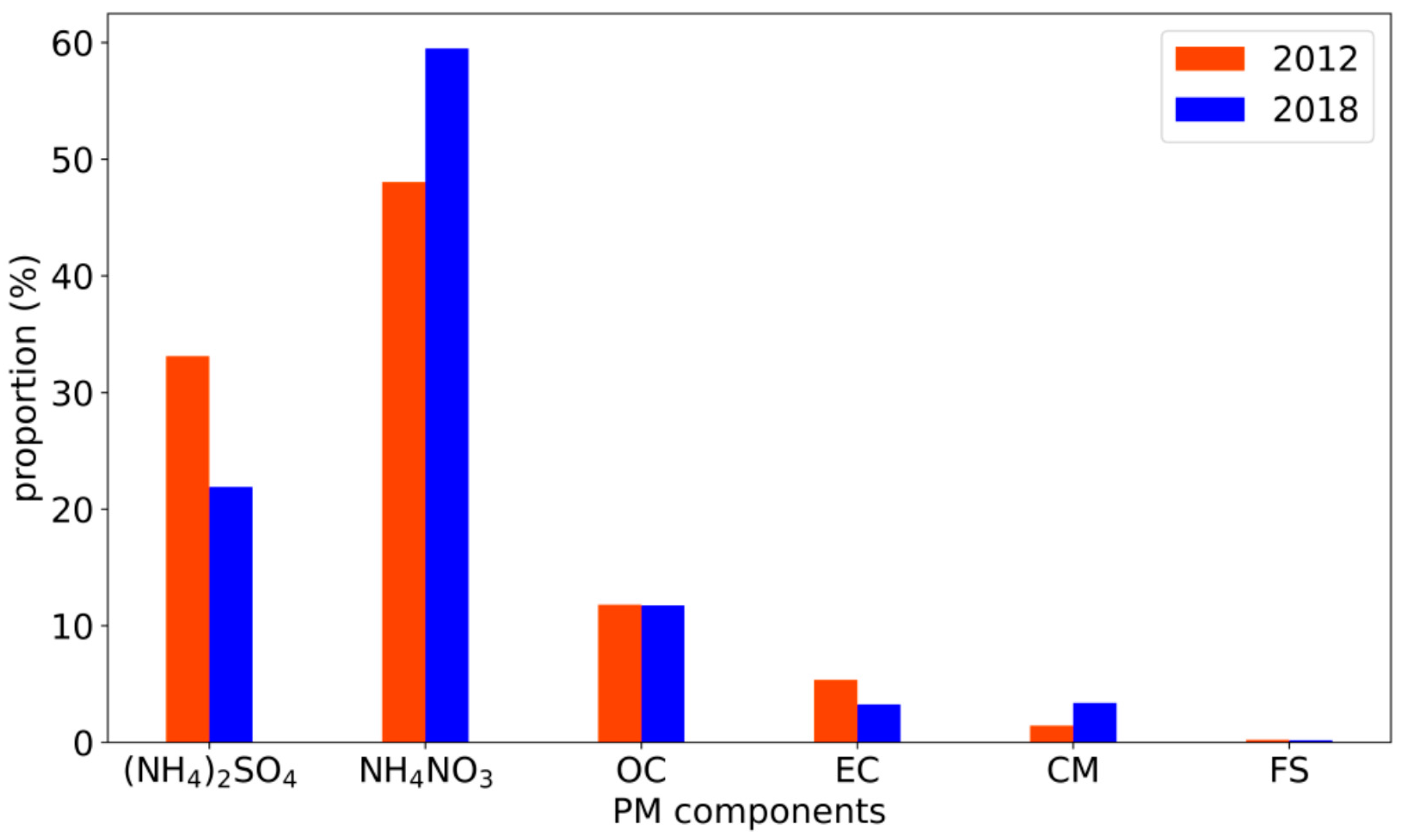
| Sources | Variables | Period |
|---|---|---|
| National Institute of Environmental Research | PM2.5, PM10, SO42−, NO3−, NH4+, Ca2+, Fe2+, OC, EC, and NO2 | 2012–2018 |
| Korea Meteorological Administration | Visibility, precipitation, relative humidity, and yellow dust events | 2012–2018 |
| National Air Emission Inventory and Research Center | SOx, NOx, and NH3 emissions | 2012–2018 |
| Institute | The Composite Equation for the Light-Extinction Coefficient |
|---|---|
| IMPROVE_1994 | 3f(RH)([NHSO 1] + [NHNO 2]) + 4[OMC 3] + 10[EC] + 1[FS 4] + 0.6[CM 5] + babs,NO2 + bRay |
| IMPROVE_2007 | 2.2fS(RH)[Small Ammonium Sulfate] + 4.8fL(RH)[Large Ammonium Sulfate] + 2.4fS(RH)[Small Ammonium Nitrate] + 5.1fL(RH)[Large Ammonium Nitrate] + 2.8[Small Organic Mass] + 6.1[Large Organic Mass] + 10[Elemental Carbon] + 1[Fine Soil] + 1.7fSS(RH)[Sea Salt] + 0.6[Coarse Mass] + Rayleigh Scattering (Site Specific) + 0.33[NO2 (ppb)] |
| NIER | 0.91(3[NHSO](1-RH/100)−0.7) + 1.34(3[NHNO](1 − RH/100)−0.7) + 1.06(4[OMC](1 − RH/100)−0.4) + 0.98(10[EC]) + 2[FS] + 0.6[CM] + 153.53 |
| Variables | PM2.5 | SO42− | NO3− | NH4+ | OC | EC |
|---|---|---|---|---|---|---|
| Trend (µg yr−1) 1 | −2.3 ± 5.2 ** 2 | −1.0 ± 1.2 *** | −0.3 ± 2.8 | −0.3 ± 0.8 * | 0.0 ± 0.4 | −0.1 ± 0.1 *** |
| R with PM2.5 | − | 0.83 | 0.73 | 0.96 | 0.60 | 0.92 |
| R with visibility | −0.96 | −0.76 | −0.72 | −0.92 | −0.76 | −0.82 |
| Variables | PM2.5 | SO42− | NO3− | NH4+ | OC | EC |
|---|---|---|---|---|---|---|
| Trend (µg yr−1) 1 | −2.6 ± 4.3 *** 2 | −1.6 ± 1.6 *** | 0.2 ± 3.4 | −0.3 ± 0.8 * | 0.0 ± 0.7 | −0.2 ± 0.2 *** |
| R with PM2.5 | − | 0.95 | 0.12 | 0.83 | 0.23 | 0.82 |
| R with visibility | −0.55 | −0.38 | −0.60 | −0.77 | −0.03 | 0.01 |
| Emission | SOx | NOx | NH3 |
| −39.8 | 17.6 | 3.4 | |
| Concentration | SO42− | NO3− | NH4+ |
| −36.7 | 27.0 | −1.7 |
| (NH4)2SO4 | NH4NO3 | |
|---|---|---|
| Concentration | −8.7 | 6.2 |
| Light-extinction coefficient | −50 | 91 |
Publisher’s Note: MDPI stays neutral with regard to jurisdictional claims in published maps and institutional affiliations. |
© 2022 by the authors. Licensee MDPI, Basel, Switzerland. This article is an open access article distributed under the terms and conditions of the Creative Commons Attribution (CC BY) license (https://creativecommons.org/licenses/by/4.0/).
Share and Cite
Jeong, J.I.; Seo, J.; Park, R.J. Compromised Improvement of Poor Visibility Due to PM Chemical Composition Changes in South Korea. Remote Sens. 2022, 14, 5310. https://doi.org/10.3390/rs14215310
Jeong JI, Seo J, Park RJ. Compromised Improvement of Poor Visibility Due to PM Chemical Composition Changes in South Korea. Remote Sensing. 2022; 14(21):5310. https://doi.org/10.3390/rs14215310
Chicago/Turabian StyleJeong, Jaein I., Jisu Seo, and Rokjin J. Park. 2022. "Compromised Improvement of Poor Visibility Due to PM Chemical Composition Changes in South Korea" Remote Sensing 14, no. 21: 5310. https://doi.org/10.3390/rs14215310
APA StyleJeong, J. I., Seo, J., & Park, R. J. (2022). Compromised Improvement of Poor Visibility Due to PM Chemical Composition Changes in South Korea. Remote Sensing, 14(21), 5310. https://doi.org/10.3390/rs14215310






